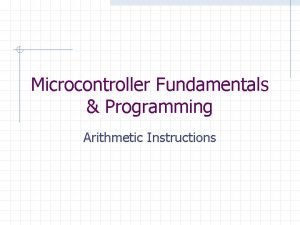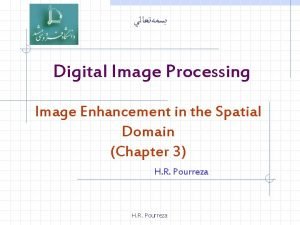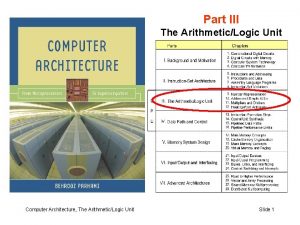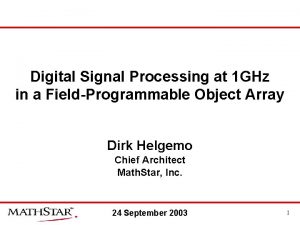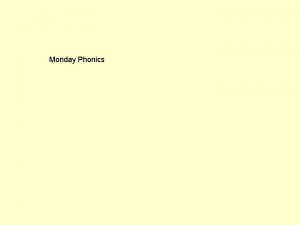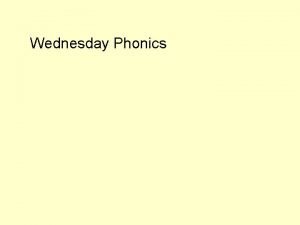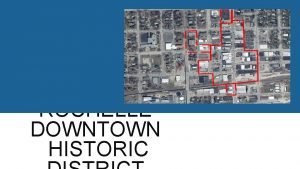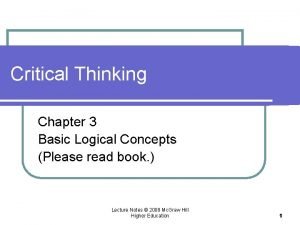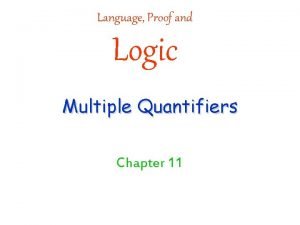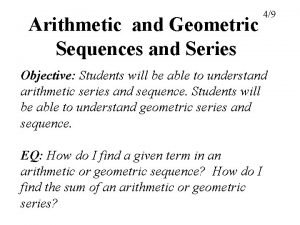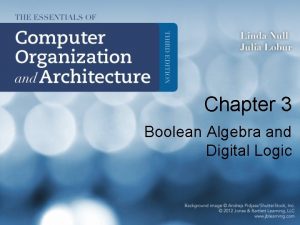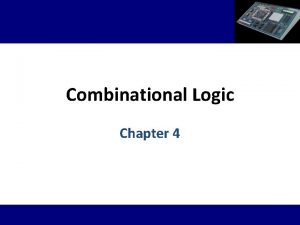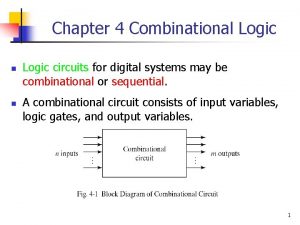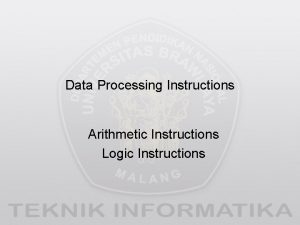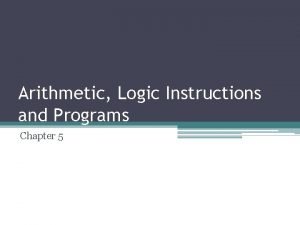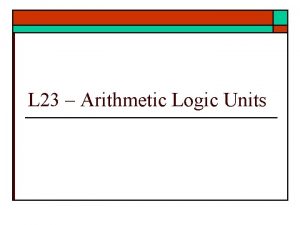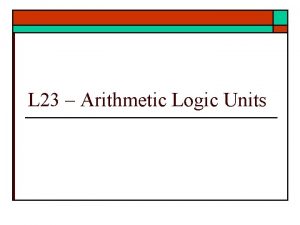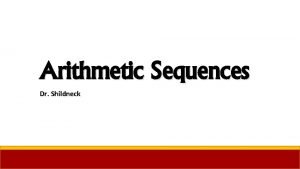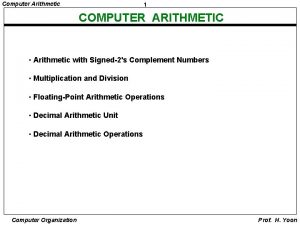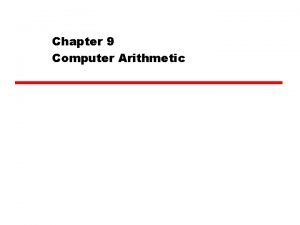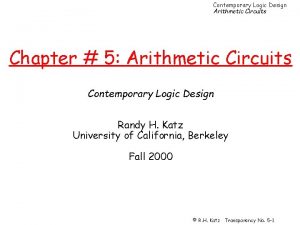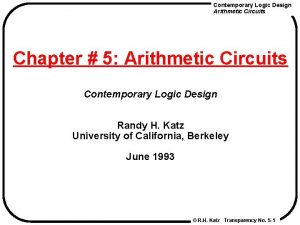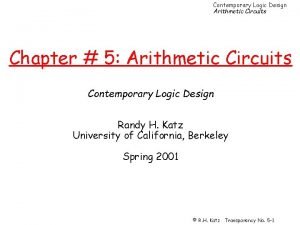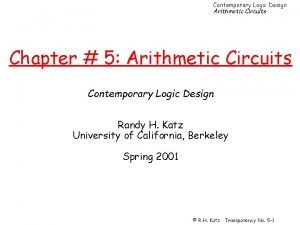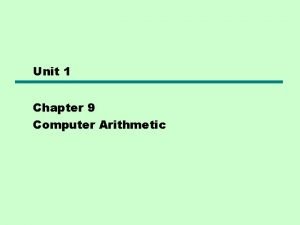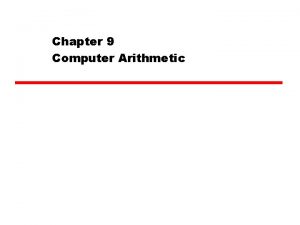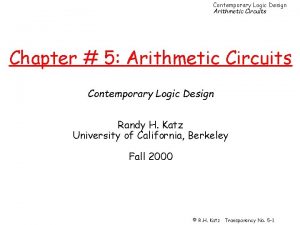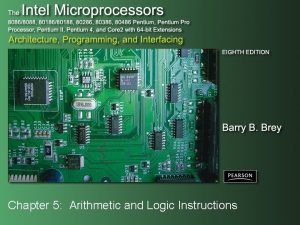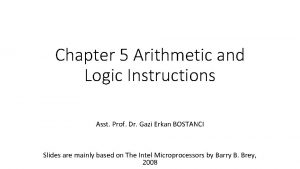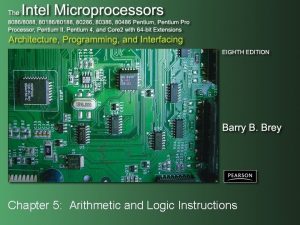Arithmetic and Logic Instructions Thorne Chapter 6 7



























- Slides: 27

Arithmetic and Logic Instructions Thorne : Chapter 6, 7, 9 (Irvine, Edition IV : 4. 1, 4. 2, 6. 2 7. 2, 7. 3, 7. 4) SYSC 3006 1

Breakdown of Intel 8086 Assembly Instructions 1. Data transfer: copy data among state variables (registers, memory and I/O ports) • Their execution do not modify FLAGS • eg. MOV instruction 2. Data manipulation: modify state variable values • Executed within the ALU data path • Their execution do modify the FLAGS • eg. Arithmetic : ADD, SUB, CMP • eg. Logical : AND, OR, NOT, XOR • eg. Shift, Rotate : SHL, SAR, RCL, ROL 3. Control-flow: determine “next” instruction to execute • Their execution allow non-sequential execution • eg. JMP and JE SYSC 3006 2

Data Manipulation Instructions Compute new value … modify flags Some common flag results : ZF = zero flag set iff result = 0 CF = carry flag reflect carry value set = 1, clear = 0 SF = sign flag set iff result < 0 assumes 2’s complement encoding! iff ==If-and-only-if OF = overflow flag set iff signed overflow specific use of “overflow” – not the same as the general concept! SYSC 3006 3

Signed versus Unsigned Arithmetic • These operations perform a bitwise add/subtract of values of width n to give a result of width n • 8 -bit Unsigned Integer Examples: 11710 = 0111 01012 + 9910 = 0110 00112 21610 = 1101 10002 13310 = 1000 01012 – 5110 = 00112 8210 = 0101 00102 SYSC 3006 4

Arithmetic Operations : Binary Addition and Subtraction 8 -bit Signed Integer Examples: · The computer does exactly the same thing for 2’s complement signed integers! Signed is now being used to mean 2’s complement signed -11710 = 1000 10112 + 9910 = + 0110 00112 - 1810 = 11102 ( 00012 +1 = 12 h=18 d) -3210 = 1110 00002 – 510 = – 0000 01012 -3710 = 1101 10112 ( 0010 01002 +1 = 25 h=37 d) SYSC 3006 5

Arithmetic Operations : Binary Addition and Subtraction Computers often implement subtraction using “negate and add” X – Y = X + (– Y) Example : 32 – 65 = 32 + (-65) 3210 = 0010 00002 + – 6510 = + 1011 11112 ( 0100 00002 +1 = 41 h = 65 d) – 3310 = 1101 11112 ( 0010 00002 +1 = 21 h = 33 d) SYSC 3006 6

Overflow : The Concept Overflow : Result of operation outside the range that can be represented – Problem arising due to limited range of fixed-width representation. – Result is still produced; the result is just meaningless. • 8 -bit Unsigned Integer Example: What is the range of 25510 = 11112 an 8 -bit unsigned We need 9 + 110 = 0000 00012 bits to number ? represent the 256 ? ? 010 = (1) 00002 result CARRY – In this case (with fixed 8 -bits) : OVERFLOW OCCURRED! CF=1 – In this case (unsigned) : A carry @ MSB is important in the INTERPRETATION of the result. SYSC 3006 7

Addition and Subtraction Overflow Is that the only interpretation of the example? + (1) 11112 ( = – 110) 0000 00012 ( = + 110) 00002 ( = 010) Same binary pattern ! • What if the values are interpreted as 8 -bit signed integers ? – The result is correct ( – 1 + 1 = 0 ). There is no overflow. OF=0 (CF=1) – In this case (signed), the carry at MSB still occurs but is not important to the interpretation! – ZF = ? SF = ? Overflow: • Carry flag (CF) for unsigned numbers • Overflow flag (OF) for signed numbers SYSC 3006 8

Addition and Subtraction Overflow Another example : With Borrow 8 -bit result 3210 = 0010 00002 8 -bit result – 6510 = 0100 00012 – 3310 = 1 1101 11112 ( = + 22310 : unsigned) ( = – 3310 : signed) • If the values are interpreted as unsigned, the borrow implies overflow (actually, underflow) : the result is WRONG. • If the value are interpreted as signed, there is no overflow; ignore the borrow : the result is CORRECT. CF = 1 SYSC 3006 OF = 0 SF = 1 ZF = 0 9

Addition and Subtraction Overflow depends on the interpretation of the values. Another example: 0111 11112 + 0000 00012 1000 00002 unsigned 127 + 1 128 CORRECT CF = 0 (CF → unsigned number) OF = 1 (OF → signed number) SF = 1 SYSC 3006 signed 127 + 1 – 128 WRONG OVERFLOW … even though there is no carry outside of fixed width! But … there is carry to MSB (sign bit)! 10

Overflow Cookie Cutters Unsigned: Carry or borrow means overflow borrow 0 2 N-1 carry Signed : Ignore carry or borrow Overflow possible if : positive + positive = negative ( positive – negative = negative ) negative + negative = positive ( negative – positive = positive ) Overflow impossible if : positive + negative ( positive – positive ) negative + positive (negative – negative ) SYSC 3006 11

Data Manipulation : ADD Example: Suppose that AL contains 73 H, when it is executed : execute: ADD AL, 40 H 73 H + 40 H = B 3 H carry? results: AL : = B 3 H ( = 1011 0011 B) ZF : = 0 result 0 SF : = 1 result is negative (signed) CF : = 0 (no carry out of msbit) OF : = 1 +ve + +ve = ve Correct result for unsigned number (CF = 0) Wrong result for signed number (OF = 1) SYSC 3006 12

Problem : Write a program to perform the following operation : z = x + y where x = 55667788 h and y = 99669988 h Solution: . data x DW 7788 h DW 5566 h y DW 9988 h 1 111 DW 9966 h 5566 7788 z DW ? + 9966 9988 DW ? EECD 1110 EECC 1110. code (BX) (AX) MOV AX, x MOV BX, x+2 ADD AX, y → CF=1 ADD BX, y+2 → ADC BX, y+2 BX: = BX+(y+2)+CF MOV z, AX MOV z+2, BX END SYSC 3006 13

Control Flow : JMP instructions Four types of JUMP instructions: Unary (unconditional) jumps : always execute JMP target Simple jumps: jump is taken when a specific status flag is set JC target (Jump if CF=1) Conditional Jumps Unsigned jumps: jumps are taken when a comparison or test of unsigned numbers results in a specific combination of status flag JA target (Jump if above) Implication : Preceded by an instruction that alters the appropriate flags Signed jumps: jumps are taken when a comparison or test of signed quantities results in a specific combination of status flags JG target (Jump if greater than) SYSC 3006 14

Signed and Unsigned Conditional Instructions • The processor provides status flags to reflect results of (binary) manipulation under both signed and unsigned interpretations • For this reason, there are separate conditional jump instructions for signed and unsigned – Semantically equivalent but implementation tests the flags appropriate to the data type. Unsigned Signed JA Above JG Greater JAE Above or Equal JGE Greater or Equal JB Below JL Less JBE Below or Equal JLE Less or Equal • There also instructions for Not conditions too! SYSC 3006 15

Example : Conditional Branches Suppose AL contains 7 FH: Unsigned Scenario Signed Scenario CMP AL, 80 h JA JG Bigger In each scenario, is the jump taken? Why? Programmer MUST know how binary values are to be interpreted! (e. g. value in AX above) SYSC 3006 16

Limitation of J* Instructions • Conditional jump are restricted to 8 -bit signed relative offset! – IP : = IP + (offset sign-extended to 16 -bits) – Can’t jump very far! – 128 +127 bytes • Example: JL Less maximum possible distance = 127 bytes …. Less: MOV. . . • One possible workaround if distance is greater than 127 bytes (but not the only one!): JMP can have 16 -bit relative offset JNL Continue JMP Less distance can now be > 127 Continue: …. Less: MOV. . . SYSC 3006 17

Example Write a code fragment showing how you would implement the following pseudocode boolean done = FALSE; while ( ! done ) { …. } Solution: TRUE equ 1 FALSE equ 0. code MOV AL, FALSE ; AL= register variable done not. Done: CMP AL, TRUE JE am. Done ; . . ; Somewhere : MOV AL, TRUE JMP not. Done am. Done: … SYSC 3006 18

LOOP Instruction • Useful when you have an action repeated a given number of times • C++ analogy for (int i=max; i > 0; i--) MOV Do. Loop: SUB JNZ CX, max. . . CX, 1 Do. Loop Functionally equivalent Different performance & code size MOV CX, max Do. Loop: . . . LOOP Do. Loop • LOOP automatically decrements CX • Only works with CX SYSC 3006 19

Data Manipulation : DIV Unsigned Integer Division • Syntax : DIV src • Semantics : Performs an integer division : Accumulator / src – The size of divisor (8 -bit or 16 -bit) is determined by size of src – src may be specified using register, direct or indirect mode but not immediate mode 16 -bit dividend 8 -bit divisor • 8 -bit division : DIV src where src = 8 -bit operand – Semantics divide src into 16 -bit value in AX Two 8 -bit Integer result – AL : = AX src (unsigned divide) results AH : = AX mod src ( unsigned modulus) Integer remainder – The flags are undefined after DIV (values may have changed, no meaning) SYSC 3006 20

Data Manipulation : DIV 32 -bit dividend 16 -bit divisor • 16 -bit division : DIV src where src = 16 -bit operand – Semantics divide src into 32 -bit value obtained by concatenating DX and AX (written DX: AX) Two 16 bit results Integer result AX : = DX: AX src (unsigned divide) Integer remainder DX : = DX: AX mod src ( unsigned modulus) – The flags are undefined after DIV (values may have changed, no meaning) Question : In either case, what if the result is too big to fit in destination? • eg : AX 1 ? ? AL = ? ? • overflow trap – more later! SYSC 3006 21

Data Manipulation : Logical Operations Syntax : LOGICAL_MNEUMONIC dest, src Semantics : dest = dest LOGICAL_MNEUMONIC src Example : AND AL, 80 h Example : . data control DB ? . code OR control, BH (where BH=02 h) Example : XOR AX, AX XOR AX, 0 FFh AND OR XOR 0 0 0 1 0 1 1 1 0 Operation bit by bit! SYSC 3006 22

Data Manipulation : Shift • Versions for : Left/Right and Arithmetic/Logical Shift Right SHR 0 b 7 --------- b 0 C AL, 1 Arithmetic Shift Right MOV SAR b 7 --------- b 0 CL, 2 AL, CL C Logical or Arithmetic Shift Left C SHL SAL AL, 1 SYSC 3006 b 7 --------- b 0 0 23

Data Manipulation : Rotate • Versions for : Left/Right and with/out carry Rotate-Carry-Left RCL AL, 1 b 7 --------- b 0 C Rotate Left MOV CL, 4 ROL AL, CL b 7 --------- b 0 SYSC 3006 C 24

Example Write a code fragment to test whether a variable is divisible by 4, leaving the boolean result in AX. Solution: A number divisible by 4 would have the least significant two bits equal 0 s. FALSE TRUE. data variable. code MOV AND JZ MOV JMP yes: MOV continue: … equ 0 1 dw 1922 h AX, variable AX, 03 h yes AX, FALSE continue AX, TRUE SYSC 3006 Alterative : TEST variable, 03 h 25

Example Suppose a robot has four motors, each of which can be off, on in forward direction or on in reverse direction. The status of these motors are written by the robot into a status word, say called “motors” in the following bitmap formation. 7 6 Motor 1 5 4 Motor 2 3 2 Motor 3 1 0 Motor 4 where the two bits for each motor are set according 01 forward 10 reverse 11 off Write a code fragment that waits until motor 1 is off before continuing on. … SYSC 3006 26

Solution: . data motors db ? . code waiting: MOV AL, motors AND AL, 0 C 0 h CMP AL, 0 C 0 h JNZ waiting … SYSC 3006 27
 Difference between adca and adda
Difference between adca and adda Microprogram sequencer
Microprogram sequencer Combining spatial enhancement methods
Combining spatial enhancement methods The control unit of cpu
The control unit of cpu Arithmetic logic unit
Arithmetic logic unit First order logic vs propositional logic
First order logic vs propositional logic First order logic vs propositional logic
First order logic vs propositional logic First order logic vs propositional logic
First order logic vs propositional logic Combinational logic circuit vs sequential
Combinational logic circuit vs sequential Cryptarithmetic problem logic+logic=prolog
Cryptarithmetic problem logic+logic=prolog Software development wbs
Software development wbs Is it x y or y x
Is it x y or y x Combinational logic sequential logic 차이
Combinational logic sequential logic 차이 Combinational logic sequential logic
Combinational logic sequential logic Is bella thorne dyslexia
Is bella thorne dyslexia Kip thorne education
Kip thorne education Mr thorne does phonics ay
Mr thorne does phonics ay A-e
A-e Thorne demolition
Thorne demolition Helen thorne
Helen thorne Rochelle thorne
Rochelle thorne Logic and critical thinking chapter 2
Logic and critical thinking chapter 2 Inductive generalization
Inductive generalization Language proof and logic solutions chapter 11
Language proof and logic solutions chapter 11 Arithmetic and geometric sequences and series
Arithmetic and geometric sequences and series Logic chapter 3
Logic chapter 3 Logic chapter four
Logic chapter four Table of 32
Table of 32
